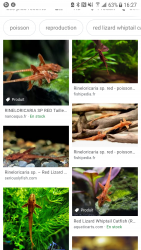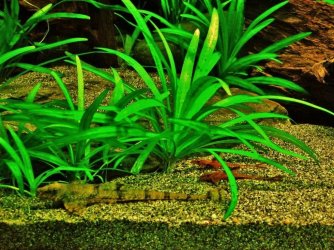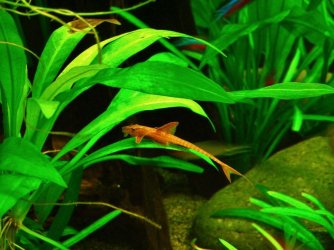Thank you! I didn't think about these fish, I will have to do some research but it's a really good ideaI have always been fond of the common whiptail, Rineloricaria parva. They are fine as a solitary individual, or two or three. The length is 11-12 cm (5 inches max) but they are so narrow you really don't notice this, and their impact on the biological system is a fraction that of a BN or similar pleco. I think I've had one of these fish in a tank ever since I entered the hobby in the 1980's. The photo below is my present representative, who has entered its 12 year with me, pretty good for a fish with an average expected lifespan of 5-8 years. It's on the wood at the left, and second photo on the substrate. I also have (photo 3) one of the so-called Red Lizard Whiptails, though it is more brown than red, but I have never seen them interact at all even when they are next to each other. Avoid the "Royal" whiptails, that is a different genus and the fish are considerably larger.
There are three different species regularly offered as "Whiptail" Catfish--Rineloricaria fallax, R. lanceolata and R. parva--that have slight variations in pattern and the placement of the ventral scutes. It is also possible that some available fish may be hybrids between these three and other species. All have identical requirements in the aquarium.
Whiptails should be maintained in well-planted tanks having a small-sized gravel or sand substrate, with chunks of bogwood. Leaves can be laid on parts of the substrate. Overhead lighting should be minimal and/or diffused with floating plants. This catfish tends to remain on the substrate, but will also continually browse plant leaves, wood and rock as well as the substrate for algae and bits of food; they prefer to rest in wood crevices or under wood or rock outcrops. They do not eat plants.
Some authors have suggested moving this species (along with several others) into the genus Hemiloricaria; Planet Catfish has adopted this, but the species is taxonomically deemed valid as Rineloricaria.
-
Guest, the Tank of the Year contest is underway!
💧 Which tank will win? 👉 View the entries and vote now!!
You are using an out of date browser. It may not display this or other websites correctly.
You should upgrade or use an alternative browser.
You should upgrade or use an alternative browser.
Bristlenose pleco + vacation questions
- Thread starter Meg0000
- Start date
Wow they are amazing!I acquired three of the Red Lizards in 2014, here's a photo of two with the regular whiptail, and one on a plant leaf.
I don't want to start a thread for this but @Byron I think you could help me. I didn't realized the rocks I had would affect GH when I bought them and it did. I don't know how it is exactly because I only have a PH test kit and my normal tap water PH is 6.6-6.8 and when I search on internet I have soft to very soft water. Now the PH is 7.2 so the GH is surely higher but I don't know if it high enough to affect my fish. What do you think?
Rineloricaria sp. L010a
Family: Loricariidae, Subfamily Loricariinae
Common Names: Red Lizard Whiptail Catfish, Red Lizard Cat
Origin and Habitat: Some sources believe this is a distinct wild species from South America, but most accept that it was more probably developed by hobbyists in Germany, though the original parent species are unknown. It is a Loricarid, closely related to the species in Rineloricaria.
Compatibility/Temperament: Very peaceful and somewhat secretive; males will be territorial when spawning. Well suited to almost any community aquarium with peaceful and non-aggressive fish.
Diet
Omnivorous, but not as "vegetarian" as its relative the Whiptail Catfish. Will accept any sinking prepared foods, frozen bloodworms, small live worms, and vegetable matter like blanched spinach, yam, zucchini. Will not damage live plants as it browses their leaves.
Size: Attains 4.5 inches; females are slightly smaller than males.
Minimum Tank Suggestion: 10 gallons
Water parameters Soft to medium hard (< 15 dGH), acidic to slightly basic (pH 5 to 7.5), temperature 22-28C/71-82F.
Description
The precise origin of this fish is a mystery. It may possibly be a natural species, but most sources believe it is a man-made hybrid from one or more other Rineloricaria species, but which exactly is also unknown. The German aquarium resource publisher Aqualog introduced this species with the number L010a, but it bears no resemblance to L010. The "L" system was initiated by the German aquarium magazine DATZ [Die Aquarien und Terrarienzeitschrift] to identify the newly-discovered loricarid species prior to the scientific description and naming; these numbers are applied to all known species including those already or once named, so they are unique to each species.
The aquarium should be dimly lit and provided with a substrate of sand or fine gravel that is smooth; this fish likes to occasionally burrow, and sharp-edged materials will cause damage to the underbelly and mouth. Hiding places formed by bogwood or rock should be provided; PVC pipe is also suitable. A well-planted aquarium suits this species which likes to browse all surfaces for food. It will stop to rest for longer periods than many similar species, and may thus be almost un-noticed; in the writer's (Byron) aquarium they will hang vertically on the leaves or stems of Echinodorus plants.
The species will spawn inside a hollow such as PVC pipe, with the male guarding the nest in typical Rineloricaria fashion. Mature males have small spines (called odontodes) on the pectoral fins and around the head, but unlike other species not on the top of the head.
The "pure" strain of this species is now very difficult to obtain, probably only from Germany. It is more likely that fish available in stores will be hybrids. It was found that the original species, sometimes referred to as Leliella sp. "Red," would readily spawn with Rineloricaria lanceolata. Since the latter species is more prolific and easier to spawn, and this hybridization produces very red-coloured fish, commercial breeders preferred the hybrids. The pure species is preserved by some breeders in Germany.
The genus Rineloricaria was erected by Pieter Bleeker in 1862; the name is derived from the Greek rhinos [= nose] and lorica [= cuirass (which is a type of armour breastplate) of leather]. There are presently about 60 described species distributed from Panama down to northern Argentina, and on both sides of the Andes. This is the largest number of species in any Loricariinae genus. In 2008 alone, some 14 new species were described within Rineloricaria.
During the past ten years this genus has undergone classification changes which are still not fully resolved. Isbrucker et al.(2001) re-established the genus Hemiloricaria [Bleeker, 1862] as distinct, along with two new genera (Leliella and Fonchiiichthys), and on the basis of sexual dimorphism moved several species from Rineloricaria into these three. The latest classification, that of Rodriguez & Reis (2008), partly accepts Isbrucker et al. (2001) phenetic proposition of splitting Rineloricaria and Hemiloricaria; but they propose that Hemiloricaria should comprise a widely-distributed group of species (Amazon and non-Amazon species) whereas Rineloricaria would be restricted to species occurring in the Rio Parana and its tributaries, and the coastal drainages from Uruguay to northeastern Brazil. As of the time of writing, this has not been universally accepted.
References:
Isbrucker, I. J. H., I. Seidel, P. Michels, E. Schraml and A. Werner (2001), "Diagnose vierzehn neuer Gattungen der Familie Loricariidae Rafinesque, 1815 (Teleostei, Ostariophysi)," Datz-Sonderheft, vol. 2, pp. 17-24.
Rodriguez, M. S. and R. E. Reis (2008), "Taxonomic review of Rineloricaria (Loricariidae, Loricariinae) from the Laguna dos Patos drainage, Southern Brazil, with the descriptions of two new species and the recognition of two species groups," Copeia 2008(2), pp. 333-349.
Tullmann, Sandor (2009), PlanetCatfish website.
Family: Loricariidae, Subfamily Loricariinae
Common Names: Red Lizard Whiptail Catfish, Red Lizard Cat
Origin and Habitat: Some sources believe this is a distinct wild species from South America, but most accept that it was more probably developed by hobbyists in Germany, though the original parent species are unknown. It is a Loricarid, closely related to the species in Rineloricaria.
Compatibility/Temperament: Very peaceful and somewhat secretive; males will be territorial when spawning. Well suited to almost any community aquarium with peaceful and non-aggressive fish.
Diet
Omnivorous, but not as "vegetarian" as its relative the Whiptail Catfish. Will accept any sinking prepared foods, frozen bloodworms, small live worms, and vegetable matter like blanched spinach, yam, zucchini. Will not damage live plants as it browses their leaves.
Size: Attains 4.5 inches; females are slightly smaller than males.
Minimum Tank Suggestion: 10 gallons
Water parameters Soft to medium hard (< 15 dGH), acidic to slightly basic (pH 5 to 7.5), temperature 22-28C/71-82F.
Description
The precise origin of this fish is a mystery. It may possibly be a natural species, but most sources believe it is a man-made hybrid from one or more other Rineloricaria species, but which exactly is also unknown. The German aquarium resource publisher Aqualog introduced this species with the number L010a, but it bears no resemblance to L010. The "L" system was initiated by the German aquarium magazine DATZ [Die Aquarien und Terrarienzeitschrift] to identify the newly-discovered loricarid species prior to the scientific description and naming; these numbers are applied to all known species including those already or once named, so they are unique to each species.
The aquarium should be dimly lit and provided with a substrate of sand or fine gravel that is smooth; this fish likes to occasionally burrow, and sharp-edged materials will cause damage to the underbelly and mouth. Hiding places formed by bogwood or rock should be provided; PVC pipe is also suitable. A well-planted aquarium suits this species which likes to browse all surfaces for food. It will stop to rest for longer periods than many similar species, and may thus be almost un-noticed; in the writer's (Byron) aquarium they will hang vertically on the leaves or stems of Echinodorus plants.
The species will spawn inside a hollow such as PVC pipe, with the male guarding the nest in typical Rineloricaria fashion. Mature males have small spines (called odontodes) on the pectoral fins and around the head, but unlike other species not on the top of the head.
The "pure" strain of this species is now very difficult to obtain, probably only from Germany. It is more likely that fish available in stores will be hybrids. It was found that the original species, sometimes referred to as Leliella sp. "Red," would readily spawn with Rineloricaria lanceolata. Since the latter species is more prolific and easier to spawn, and this hybridization produces very red-coloured fish, commercial breeders preferred the hybrids. The pure species is preserved by some breeders in Germany.
The genus Rineloricaria was erected by Pieter Bleeker in 1862; the name is derived from the Greek rhinos [= nose] and lorica [= cuirass (which is a type of armour breastplate) of leather]. There are presently about 60 described species distributed from Panama down to northern Argentina, and on both sides of the Andes. This is the largest number of species in any Loricariinae genus. In 2008 alone, some 14 new species were described within Rineloricaria.
During the past ten years this genus has undergone classification changes which are still not fully resolved. Isbrucker et al.(2001) re-established the genus Hemiloricaria [Bleeker, 1862] as distinct, along with two new genera (Leliella and Fonchiiichthys), and on the basis of sexual dimorphism moved several species from Rineloricaria into these three. The latest classification, that of Rodriguez & Reis (2008), partly accepts Isbrucker et al. (2001) phenetic proposition of splitting Rineloricaria and Hemiloricaria; but they propose that Hemiloricaria should comprise a widely-distributed group of species (Amazon and non-Amazon species) whereas Rineloricaria would be restricted to species occurring in the Rio Parana and its tributaries, and the coastal drainages from Uruguay to northeastern Brazil. As of the time of writing, this has not been universally accepted.
References:
Isbrucker, I. J. H., I. Seidel, P. Michels, E. Schraml and A. Werner (2001), "Diagnose vierzehn neuer Gattungen der Familie Loricariidae Rafinesque, 1815 (Teleostei, Ostariophysi)," Datz-Sonderheft, vol. 2, pp. 17-24.
Rodriguez, M. S. and R. E. Reis (2008), "Taxonomic review of Rineloricaria (Loricariidae, Loricariinae) from the Laguna dos Patos drainage, Southern Brazil, with the descriptions of two new species and the recognition of two species groups," Copeia 2008(2), pp. 333-349.
Tullmann, Sandor (2009), PlanetCatfish website.
I don't want to start a thread for this but @Byron I think you could help me. I didn't realized the rocks I had would affect GH when I bought them and it did. I don't know how it is exactly because I only have a PH test kit and my normal tap water PH is 6.6-6.8 and when I search on internet I have soft to very soft water. Now the PH is 7.2 so the GH is surely higher but I don't know if it high enough to affect my fish. What do you think?
First thing is to confirm the source (tap) water pH. Did you out-gas the CO2 before testing?
No I never heard of doing thatFirst thing is to confirm the source (tap) water pH. Did you out-gas the CO2 before testing?
No I never heard of doing that
You can let a glass of tap water sit 24 hours, then test pH. Or sometimes it works by vigorously agitating the water in a jar with a lid. This (whichever) outgasses the CO2 so you get a more accurate pH reading. Only needed for tap water because there can be a lot of CO2 dissolved in the water as it passes through the pipes. The buybbles you see after a water change is the dissolved CO2. Not needed for aquarium water.
Ok I will do the second method and come back with the resultsYou can let a glass of tap water sit 24 hours, then test pH. Or sometimes it works by vigorously agitating the water in a jar with a lid. This (whichever) outgasses the CO2 so you get a more accurate pH reading. Only needed for tap water because there can be a lot of CO2 dissolved in the water as it passes through the pipes. The buybbles you see after a water change is the dissolved CO2. Not needed for aquarium water.
The pH seems to be increasing, but you do need to test GH. Using crushed coral for example to "buffer" will raise pH but not GH. The GH and KH being low in the tap water means the pH is easily affected by other forces. And the rock may be behind this.
Ok thank you I will probably buy a GH/KH test kit next time I go at my LFSThe pH seems to be increasing, but you do need to test GH. Using crushed coral for example to "buffer" will raise pH but not GH. The GH and KH being low in the tap water means the pH is easily affected by other forces. And the rock may be behind this.
Similar threads
- Replies
- 2
- Views
- 861
- Replies
- 145
- Views
- 12K
- Replies
- 10
- Views
- 692
- Replies
- 0
- Views
- 912
Most reactions
-
 353
353 -
 160
160 -
 146
146 -
 143
143 -
 138
138 -
 127
127 -
 125
125 -
 113
113 -
 87
87 -
 85
85 -
 74
74 -
 73
73 -
 59
59 -
 53
53 -
F
52




